The skin of the almonds

If you like almonds, in their dried fruit version, you must use them quite often in cooking or baking, whether powdered or whole.
It is not obvious, but in fact there is 2 kinds of almonds in the market, wholesale with or without the skin.
It is not obvious, but in fact there is 2 kinds of almonds in the market, wholesale with or without the skin.
23 K 4.7/5 (15 reviews)
Keywords for this post:AlmondsDry fruitSkinWhiteGreyLast modified on: February 8th 2020
The skin of the almonds
For whole almonds, there are 2 versions in stores: so-called "white" or "blanched" almonds, ie without their brown skin, and "whole" almonds with their skin.
For the almond powder, there is the same powder known as "white almonds" where they are almonds without the skin which are reduced to powder, and the so-called "gray" almond powder where they are the almonds. whole which are crushed.
Then there is a question of aesthetics: the white almond powder is purer, which means that it does not color the preparation in which it is incorporated, which can sometimes be something desired. The most common example is the marzipan, if you want to obtain a smooth paste and of uniform color, it is better to use white almond powder.
So you can see that casually, this skin of almonds which seems quite harmless has consequences on your future pastries, and (a little) on your wallet also, the powder of gray almonds and whole almonds are less expensive than the white ones.
If you have to do it for hazelnuts for example, the best way is to roast them in the oven for 15 minutes at 320°F (160°C), then rub them out of the oven in a tea towel, the skin comes off in the form of a powder that you can dispose.
In summary: For almonds always prefer the version with the skin, much better, unless you need aesthetic purity (marzipan, macaroons), and for other dried fruits, hazelnuts in in particular, it is the opposite, prefer the version without the skin.
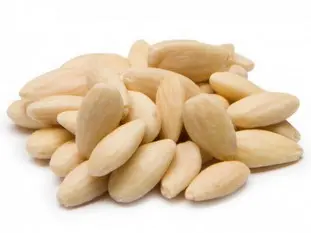
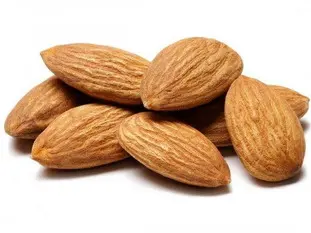
For the almond powder, there is the same powder known as "white almonds" where they are almonds without the skin which are reduced to powder, and the so-called "gray" almond powder where they are the almonds. whole which are crushed.

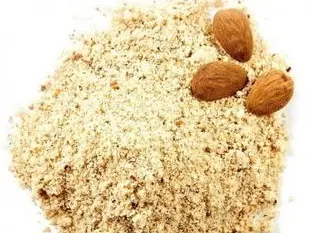
Is there a difference?
Yes, and it is important, first of all the taste: whole almonds, with their skin therefore, have more taste than white almonds, precisely because the skin participates in the taste. It's pretty easy to check, bite into one then the other, and you'll quickly feel the difference. So as a general rule, it is better to use whole almonds or gray powder, your cake or whatever you bake will be better for it.Then there is a question of aesthetics: the white almond powder is purer, which means that it does not color the preparation in which it is incorporated, which can sometimes be something desired. The most common example is the marzipan, if you want to obtain a smooth paste and of uniform color, it is better to use white almond powder.
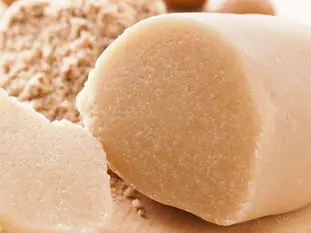
So you can see that casually, this skin of almonds which seems quite harmless has consequences on your future pastries, and (a little) on your wallet also, the powder of gray almonds and whole almonds are less expensive than the white ones.
Does this apply to all dried fruits?
No, it's often even the opposite, see for example hazelnuts and pistachios, for these 2 it's exactly the opposite, the skin does not add anything at all, it is even quite unpleasant to the taste, and it is strongly advised to withdraw it, or to buy "hulled" ones because for both it is rather painful to withdraw.If you have to do it for hazelnuts for example, the best way is to roast them in the oven for 15 minutes at 320°F (160°C), then rub them out of the oven in a tea towel, the skin comes off in the form of a powder that you can dispose.
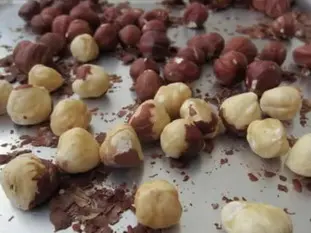
In summary: For almonds always prefer the version with the skin, much better, unless you need aesthetic purity (marzipan, macaroons), and for other dried fruits, hazelnuts in in particular, it is the opposite, prefer the version without the skin.
Lasts posts
Butter vs. grease
We often read in a recipe where a pastry is put into a mould that, just before pouring, the mould should be buttered or greased. But what's the difference between these 2 terms?December 1st 20258865
Getting out of the fridge early
Very often when you're cooking, you need to take food or preparations out of the fridge, to use them in the recipe in progress. There's nothing tricky about this: you just take them out of the fridge and use them, usually immediately, in the recipe. But is this really a good method?November 24th 20251,0475
Who's making the croissants?
When you look at a bakery from the outside, you naturally think that in the bakery, the bakers make the bread, and in the laboratory, the pastry chefs make the cakes. It's very often like that, with each of these professions having quite different ways of working, but sometimes there's also one...November 23th 2025943
Oven height
When we put a dish or cake in the oven, we naturally tend to put it on the middle shelf, and that's what we usually do. But in some cases, this position and height can be a little tricky, so let's find out why.October 8th 20252,6035
The importance of sieving
In recipes that use a fine powder (flour, powdered sugar, etc.), you'll often see the advice to sift before using it. To sift is to pass the powder in question through a sieve (a very fine strainer) before incorporating it into your recipe. It's often advice, but is it really useful?September 3rd 20257,4463
Other pages you may also like
Should a sausage be pricked before cooking?
If you are using sausages in a recipe, you may have already asked yourself the question: Should you prick it before cooking it, or not? You will certainly find as many opinions "you should prick" as "you should not". Let's try to untangle all this.September 29th 201848 K4.1
Drawing a pattern in pastry
Often in the kitchen, in pastry-making, or in baking, we need to trace a pattern on a pastry. It's just a question of aesthetics but it has its effect after baking on a galette, pithiviers, pâté en croute (terrine in a pie crust), etc.May 23th 201935 K4.1
Butter doesn't make you fat, unless you eat too much of it.
Whenever I'm discussing cooking and recipes, there is one idea which comes up frequently, like this: "Oh no! But that's got butter in it" (I should add, for the sake of accuracy, that this is something I hear more frequently from women, who are almost all concerned with keeping their figure). ...March 26th 201245 K4.5
A few tips for effective kneading at home
When you have to knead dough for bread or some other recipe, you may well use a food processor or the type of machine known as a stand mixer. The best-known brands are Kenwood and KitchenAid. They are useful tools, but here are a few tips to help you get the best out of them.June 23th 2021284 K 23.8
Artichoke stalks
When preparing artichokes for cooking, you may well already know that we often need to remove the first round of leaves, if they are tatty or dirty, as well as the inedible stalk. The operative word here is “remove” , rather than “cut off”.October 25th 201653 K4.3
Post a comment or question
Follow this page
If you are interested in this page, you can "follow" it, by entering your email address here. You will then receive a notification immediately each time the page is modified or a new comment is added. Please note that you will need to confirm this following.
Note: We'll never share your e-mail address with anyone else.
Alternatively: you can subscribe to the mailing list of cooling-ez.com , you will receive a e-mail for each new recipe published on the site.









